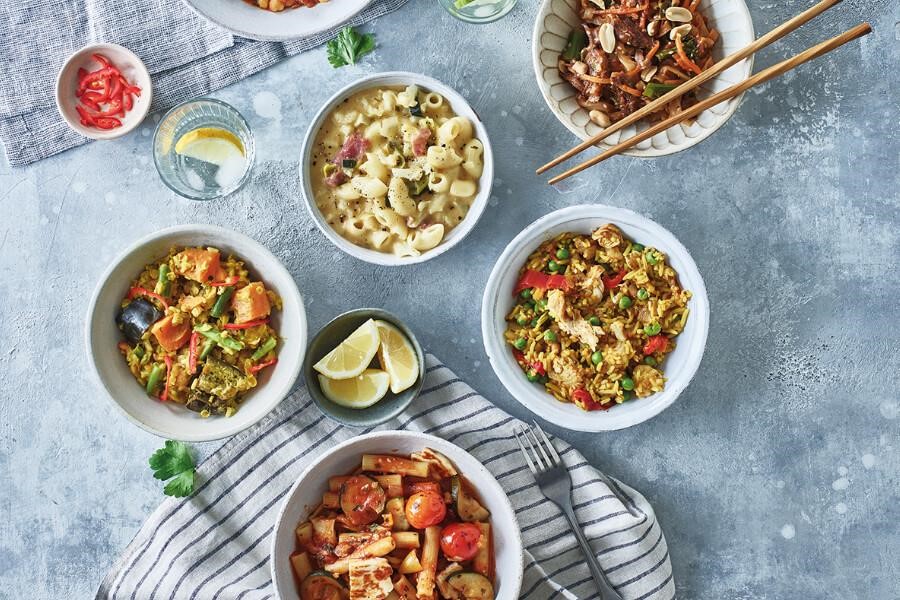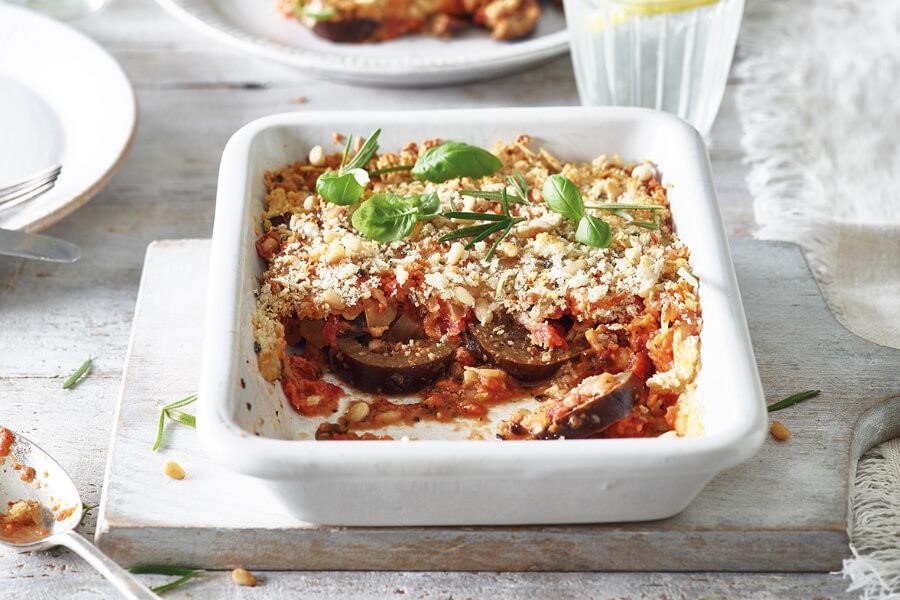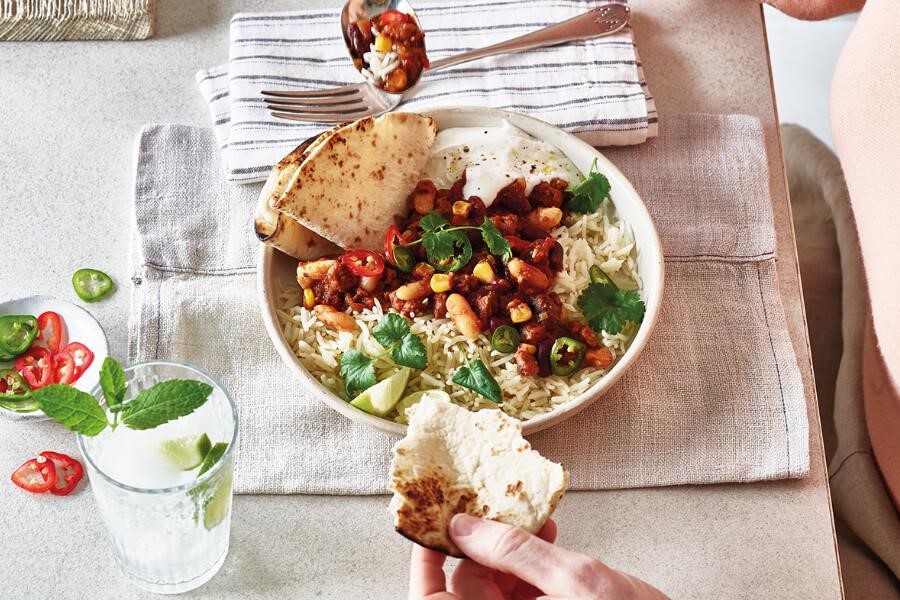
< Back to Main Blog Posted: Jan 2025
Healthy Eating Ideas
What we eat is one of the most important choices we make for our mental and physical health. The right food can help us feel good and live longer, but what is the right food? With the new year’s diet madness – “Eat this! Don’t eat that! Wait, eat this instead!” – it’s hard to know where to start. So, we’ve rounded up key healthy eating strategies for 2026, along with delicious recipes to make eating well something you actually want to do.


A Guide on How to Eat Healthily
1. Eat More Plants
In short, the microbes that live in our gut (of which there are trillions: microorganisms, including bacteria, viruses, fungi and parasites) affect pretty much all aspects of our health, from immunity to skin and even brain function. We need to make sure we have a really good range of them to maximize our well-being. To do that, we need to nourish our gut microbes, and what they love most of all is an abundant and diverse range of fibre. Where does that come from? You guessed it, plants. Our gut microbes are foodies by nature, and they can’t get enough plant goodness. They love to sample as many different plant-based ingredients as they can, so let them!
Ideally, we’d eat 30 different types of plant foods every week, which include: wholegrains, fruits, vegetables, nuts and seeds, legumes (beans and pulses) and herbs and spices (including tea and coffee). Ideally enjoy the plant in its purest form eg corn on the cob is way better than cornflakes! And don’t forget that frozen and canned fruit and veg are great as they retain the vitamins that air and light can degrade.
If you’re looking for healthy lunch ideas, we’ve got a lovely recipe for a veggie frittata. You can mix up the veg to keep it seasonal and eat it hot or cold for breakfast, lunch or dinner.
Chunky Veg and Feta Frittata
Eat More, Live Well Dr Megan Rossi
Serves 8; Prep 15 minutes; Cook: 1 hour 20 mins
Ingredients:
-
1 red onion, cut into wedges
-
1 courgette, cut into 4 long quarters
-
1 aubergine, cut into 8 long strips
-
1 red pepper, cut into 6 long strips
-
2 sweet potatoes, each cut into 6 long strips
-
1 tsp dried thyme
-
2 tsp chilli flakes (optional)
-
10 large eggs
-
50g extra virgin olive oil, plus more for drizzling
-
200g full-fat Greek yoghurt
-
8 pieces Tenderstem broccoli
-
200g feta, crumbled
Method:
Preheat the oven to about 200°C. Line a large baking tray with non-stick baking paper, into which goes all the veg except for the broccoli. Add the thyme, a good glug of olive oil, a big pinch of sea salt and chilli (if using) and mix it all together. Roast for 30 mins.
Line the base and sides of a deep 25 cm square cake tin. Layer up the now roasted veg, alternating the different types (again, just not the broc).
Stir together the eggs, olive oil and yoghurt until just combined, add a big pinch of salt and a few grinds of pepper. Pour the mixture over the veg, finally add the broccoli and crumble the feta over the top.
Reduce the oven temp to 180°C and bake for 50-60 minutes until the middle has just set – it should no longer be wobbly or jiggly (technical terms!)
Cool for at least 10 mins before serving. Good news is, it’ll keep in the fridge for up to 3 days.


If you’re after healthy dinner ideas, we’ve also got a good Ratatouille recipe, lovely and warming at this time of year.
Ratatouille
A classic recipe
Serves 4; prep time 15 mins; cooking time 30 mins
Ingredients:
-
2 aubergines, cut into chunks
-
4 courgettes, cut into chunks
-
2 peppers (not green), cut into chunks
-
4 large ripe tomatoes
-
Olive oil – lots
-
2 red onions
-
4 garlic cloves
-
1 tin of chopped tomatoes
-
1 tbsp red wine vinegar
-
1 tsp sugar
-
½ bunch of fresh basil
Method:
Heat a good glug of oil over a medium heat. Add the aubergines, courgettes and peppers, browning for about 5 mins. Set aside. Cook the onion, garlic and basil stalks until browned. Put the other veg back in the pan and stir in the tomatoes, the red wine vinegar and sugar. Season. Cook for half an hour. Add the torn basil to serve.

2. Look after your gut health
Gut health underpins overall health, and fermented foods are fantastic for our gut health as they contain “good” bacteria. These have a big impact on the immune system, giving your gut microbiome a big party, which can really help our mood. The 4 K’s are currently the most talked about fermented foods: kimchi, kefir, kombucha and kraut – even the Archers have spoken about them in Ambridge (“Fermented foods are the future” said Tom) so you know it’s a hot topic! Here are a couple of quick and easy recipes … word of warning, the Kimchi might keep more than the vampires at bay as the garlic is strooong, but you can taste it doing you good.
A Quick Kimchi recipe
BBC Good Food
Serves: 8, as a side; prep 20 mins
Ingredients:
-
1 Chinese cabbage
-
3 garlic cloves, crushed
-
2.5cm piece of ginger, grated
-
2 tbsp fish sauce (optional)
-
2 tbsp sriracha chilli sauce or chilli paste
-
1 tbsp golden caster sugar
-
3 tbsp rice vinegar
-
8 radishes, coarsely grated
-
2 carrots, cut into matchsticks or coarsely grated
-
4 spring onions, finely shredded
Method:
Slice the cabbage into 2.5cm strips and tip into a bowl. Mix in a tbsp of sea salt and set aside for a good hour. Meanwhile, you can crack on with the kimchi paste by blending the garlic, ginger, fish sauce (if using), chilli sauce, sugar and rice vinegar together.
Rinse the cabbage under cold running water, drain and dry thoroughly. Transfer to a large bowl and add the radishes, carrot, spring onions and mix it all up with the kimchi paste.
Serve straight away or pop it in a large jar, seal and leave to ferment at room temperature overnight, then chill. It’ll keep in the fridge for up to 2 weeks, and you’ll notice the flavour improving the longer it's left.
Kefir Berry Smoothie
A recipe from one of the team
Serves 1; prep 5 mins
Ingredients:
-
1 cup kefir (plain or flavored)
-
½ cup frozen mixed berries
-
1 small banana
-
1 tbsp chia seeds
-
1 tsp honey or maple syrup (optional)
Method:
Blend all ingredients until smooth. Serve immediately for a probiotic-packed start to your day.

3. Remember that fat is your friend, not the enemy.
Fat has had a bad rap since researchers first suggested that a high-fat diet was linked to unhealthy high cholesterol levels. But fat isn’t a nutritional bad guy, it’s an essential nutrient that we all need in our diets. Rather than thinking about ‘good’ or ‘bad’ fats, try thinking about foods that you can eat more often and other foods that you might want to eat less frequently. Some of our favourite sources of fat include: avocadoes, nuts, seeds, extra-virgin olive oil and we’ve thrown all of them together in this recipe (actually, it’s more of an assembly guide than a recipe!):
Smashed Avo on Sourdough
From one of the team
Serves as many as you like; prep time is just a few minutes
Method:
Smashed, well-seasoned avocado should be the star here, distributed in large random clumps on some thickly sliced sourdough bread (that’s had some olive oil drizzled over it). Crumble feta on top, in large pieces, and sprinkle with seeds. Season with salt and pepper.
And for another good mid-week meal that you can cook up for dinner and have in a Tupperware for lunch the next day…
Walnut and Basil Pesto Pasta
Recipe from one of the team
Serves 4; prep 10 mins; cook 10 mins
Ingredients:
-
400g wholegrain pasta
-
1 cup fresh basil leaves
-
½ cup walnuts
-
¼ cup grated Parmesan
-
2 garlic cloves
-
⅓ cup extra-virgin olive oil
-
Salt and pepper to taste
Method:
Cook the pasta as it tells you to. While it’s cooking, blend the basil, walnuts, Parmesan, garlic, and olive oil in a food processor until smooth. Toss the pesto with the cooked pasta and season to taste.

4. Reduce Ultra-Processed Food.
There’s lots of talk about ultra-processed foods at the moment: industrially-manufactured foods, some of which contain next-to-no nourishment and can be harmful to our health. With the best will in the world, it’s hard to avoid them completely, but the good news is that even a small reduction can have a big impact on health. So, you could start by swapping out a few products that are heavily processed, such as breakfast cereals, supermarket breads and biscuits. Tinned or instant soups are also often ultra-processed, containing a lot of additives and ingredients we don’t recognise, but it’s so easy to make a really healthy homemade soup instead, especially if you use a bone broth (great for your immune system). Check out the recipes below.
Before you tuck into them, it’s worth mentioning COOK here. To be clear, we are not ultra-processed. The clue is in our name: we COOK, we don’t ultra-process. Back in 1997, our founding statement was to COOK using the same ingredients and techniques a good cook would use at home, so all the ingredients we use are things you might find in your own kitchen cupboards. We believe in cooking natural and nutritious food then using the most natural preservative – low temperatures - to freeze it.
Chicken and Veg Soup
Recipe from Jamie Oliver
Serves 6; Prep time is a good few hours, due to the stock
Ingredients:
-
1 large onion
-
1 leek
-
2 sticks of celery
-
2 carrots
-
2 courgettes
-
200g cooked chicken
-
Olive oil
-
100g orzo
-
50g frozen peas
-
1 bunch of fresh flat-leaf parsley
Chicken stock:
-
1 chicken carcass and bones
-
1 large onion
-
2 carrots
-
2 sticks of celery
-
5 black peppercorns
Method:
For the chicken stock, peel and quarter the onions and put them in a large saucepan, with the rest of the stock ingredients.
Pour over 3 litres of cold water, and season with a bit of sea salt. Bring to the boil over a medium heat - if any froth appears on the surface, you can skim it off with a spoon. Cover with a lid, lower the heat and simmer slowly for 3 hours. (A slow cooker is great for doing this, but a pan on the hob is just fine).
Strain the broth through a sieve, throw away the solids (they’ve done their job), and leave to cool.
Now onto the soup … just peel and/or trim the onion, leek, celery and carrots, and roughly chop along with the courgettes. Shred the chicken.
Add a splash of oil to another large saucepan and place over a medium heat. In go all the veg, except for the peas, and sauté for 5 minutes.
Stir in the orzo, pour in the stock and bring to a boil. Lower the heat and simmer for about 10 mins until the veg are cooked and the orzo’s soft. Then stir in the peas and chicken until heated through. Season to taste.
Top with the herbs and serve with some fresh crusty bread.
Hearty Lentil and Spinach Soup
Recipe from one of the team
Serves 6; Prep 10 minutes; Cook 30 minutes
Ingredients:
-
1 tbsp olive oil
-
1 onion, diced
-
2 carrots, diced
-
3 garlic cloves, minced
-
1 cup red lentils, rinsed
-
4 cups vegetable stock
-
1 can chopped tomatoes
-
2 cups fresh spinach
-
Salt, pepper, and cumin to taste
Method:
Heat the oil in a large pot over a medium heat. Sauté the onion, carrots, and garlic for 5 minutes. Add the lentils, stock, and tomatoes. Bring to a boil, then reduce to simmer for 20 minutes. Stir in spinach until wilted. Season to taste.


Healthy eating isn’t just about what you eat, there are other factors to consider too.
When to eat.
That’s enough food for now. The gut needs activity time, but it also needs quiet repair time. Think of it in the same way as your body needs sleep, the gut also needs time to rest. Resting it for 12 – 14 hours is great for the immune system and also for our gut microbiome as we have microbes that help us digest and absorb our food, and then we have a different set of microbes that essentially do a kind of clean-up operation and manage inflammation – and that type of thing happens in a fasted state. Ideally we’d have a 12-hour overnight fast, and not eat from say, 8pm to 8am, sticking to an eating window of 10 – 12 hours.
How to eat.
Food is there to be enjoyed. Choose abundance rather than restriction – think about all the goodness you can add into your meal rather than purely focussing on what you should take out. Enrich rather than restrict.
And where possible, sit down and eat with friends and family, it’s a great way to retain the pleasure of eating. If you’re at work, take a proper lunch break and eat together. Research shows if you take that break, you actually get more done in the afternoon and in less time.
What to eat.
There is a lot to digest (sorry, take in) so we’re going to leave it there for now and leave you to enjoy some of the healthy meal ideas above.






















